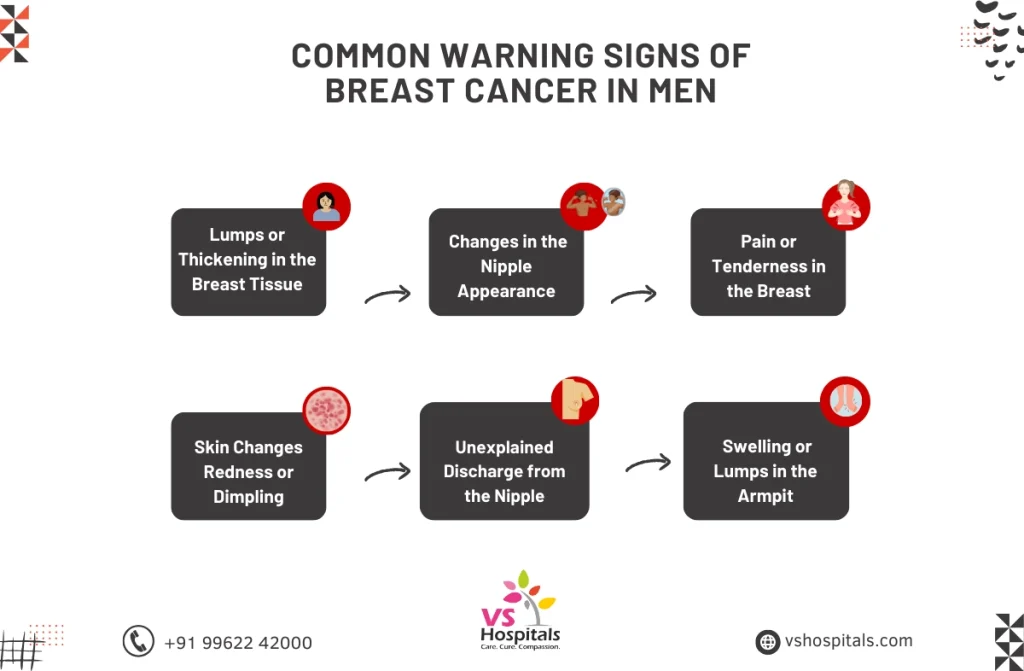Signs of breast cancer in men are not always talked about, which means many people miss the early signs and delay seeking help. That’s something we want to change. While breast cancer is more common in women, men are not immune to it and should be equally informed. Catching it early gives you the best chance for effective care, better recovery, and a healthy life. That’s why we at VS Hospitals are here to guide you through what to look for, what steps to take, and how to stay proactive about your health.
Understanding the Signs of Breast Cancer in Men
Many people don’t know that men have a small amount of breast tissue. Because of this, they can also get breast cancer. The signs can be easy to ignore at first, which is why it’s important to understand them.
- Hard Lump Near the Nipple: A painless lump, especially under or around the nipple, is the most common early sign. This lump usually feels firm and doesn’t move when touched.
- Changes in the Skin: Skin over the breast may look red, puckered, or scaly. These changes are often ignored but could mean something serious.
- Nipple Discharge or Inversion: Any discharge from the nipple, especially if it’s bloody, should not be ignored. Also, if your nipple suddenly starts turning inward, get it checked.
Understanding these changes helps catch potential health issues early. With early diagnosis, breast cancer in men treatment becomes more successful and less invasive. If you’re worried, consider learning more about the Breast Cancer Clinical Trials available at VS Hospitals, which offer access to the latest innovations in treatment.

Early Warning Signs of Breast Cancer in Men
Recognizing Warning Signs of Breast Cancer in Men is the first step to taking action. These signs might be subtle at first, but they can grow quickly.
- Unexplained Swelling: Swelling on one side of the chest or under the arm could be a warning. It may not hurt but might feel tight or full.
- Itching or Burning: Constant itching or a burning sensation around the nipple or chest area might signal something more than skin irritation.
- Color Changes in the Chest Area: If the skin around the nipple becomes darker or changes color, it could be an early warning.
Early action makes a huge difference. That’s why regular evaluations like a Biopsy Test are important when symptoms appear. It’s one of the most reliable ways to confirm or rule out breast cancer in men.
Signs and Symptoms of Breast Cancer in Men
Understanding the signs and symptoms of breast cancer in men helps you react quickly and seek care. These symptoms might not be painful, but they are still serious.
- Lump or Mass in Chest: Often hard and without pain, this lump can grow over time.
- Nipple Changes: Watch out for bleeding, scaling, or inversion of the nipple. These are not normal and should be checked.
- Pain in the Breast Area: Some men feel a deep ache or tenderness in their chest area. This could point to something more serious.
It’s important to remember that signs and symptoms of breast cancer in men vary from person to person, and understanding some breast cancer prevention tips and best practices can help in early detection and risk reduction.
What Are the Signs of Male Breast Cancer?
Many men don’t recognize the Signs of breast cancer in men until the condition gets worse. That’s why it’s essential to know what to look out for.
- Dimpled Skin
If the skin looks like an orange peel or starts to form dimples, this could be a serious sign. - Lump Attached to the Chest Wall
If the lump becomes fixed and doesn’t move, it may mean the cancer is spreading. - Swollen Lymph Nodes
Swelling under the arms or near the collarbone could be a sign that the cancer has spread.
Understanding these early symptoms allows for quicker action and opens the door to more effective breast cancer in men treatment.
What Types of Breast Cancer Affect Men?
Though it’s rare, there are several types of breast cancer men can develop. Knowing them helps with early diagnosis and proper treatment.
- Invasive Ductal Carcinoma: This is the most common type in men. It starts in the ducts and spreads to nearby tissues.
- Ductal Carcinoma In Situ (DCIS): This type is non-invasive and remains in the ducts. If found early, it’s easier to treat.
- Inflammatory Breast Cancer: Rare but aggressive, this type causes redness, swelling, and warmth in the chest.
Each type requires a unique breast cancer in men treatment strategy based on how the cancer behaves and how far it has spread
What Are the Stages of Male Breast Cancer?
The stages of male breast cancer help doctors decide the best treatment. Each stage shows how far the cancer has spread.
- Stage 0 to Stage 1: Cancer is small and hasn’t spread. This stage is the most treatable.
- Stage 2 to Stage 3: Cancer may have reached lymph nodes. Treatment is still effective but may involve surgery and chemo.
- Stage 4: Cancer has spread to other parts of the body. This stage needs more advanced care and long-term treatment.
Identifying the stage early is crucial for improving treatment outcomes. Tests like biopsies, imaging scans, and lab work are used to determine the exact stage and guide the next steps in care.
Causes of Breast Cancer in Men
The exact cause is not always known, but some things make it more likely for men to get breast cancer.
- Hormone Imbalance: Higher levels of estrogen, a hormone more common in women, may increase risk. This can happen due to liver issues or hormone therapy.
- Genetic Mutations: Inherited changes in genes like BRCA1 or BRCA2 can lead to breast cancer.
- Radiation Exposure: Men who have had radiation near the chest area have a higher risk of developing breast cancer.
Understanding these causes can help with early detection of the signs of breast cancer in men and help shape prevention strategies.
Risk Factors
Certain conditions and habits can make signs and symptoms of breast cancer in men more likely.
- Age: Most cases happen in men over 60. But younger men are not entirely safe either.
- Family History: Having close relatives with breast cancer increases your chances.
- Obesity and Lifestyle: Being overweight or leading a very inactive life can raise your risk due to hormone imbalances.
These risk factors are not guarantees but can make you more aware of Warning Signs of Breast Cancer in Men. Men with chronic conditions like chronic kidney disease may also have hormonal imbalances, raising their cancer risk.
Prevention
There is no sure way to prevent male breast cancer, but these steps can help lower the risk.
- Healthy Diet and Exercise: Eating well and staying active keeps your hormones in balance and weight in check.
- Avoid Alcohol and Smoking: Limiting these can reduce your chances of developing cancer.
- Regular Checkups: A simple exam can help catch Signs of breast cancer in men early, when they’re easiest to treat.
Men with a family history of breast cancer or other risk factors should be especially vigilant. Prevention is always easier than cure, and early awareness can make a lasting difference.
Conclusion
Signs of breast cancer should never be overlooked, especially when it comes to men’s health. At VS Hospitals, we emphasize that awareness is the first step toward timely action. Recognizing the early signs and symptoms—such as lumps, nipple discharge, or skin changes in the chest area—can lead to quicker diagnosis and more effective care. While breast cancer in men is rare, it can be just as serious and requires the same level of attention. If you or someone you care about notices any unusual changes, it’s important to seek medical advice without delay.
Read also Yoga for Breast Cancer
